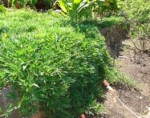Scientific Name: Ipomea batatas
Also Known As: Hawaiian Sweet Potato
Polynesian Introduction: All HI
Description: There are many different forms of Hawaiian cultivars of ‘uala, each usually with a different name. Leaf types range from triangle and heart-shaped to lobed and webbed such as the ‘uala piko variety shown here. Even the tuberous roots vary in shape and color. The different cultivars are similar in that they all generally have pinkish-purple (sometimes whitish-purple), morning glory-type flowers that creep along the ground like a vine.
Distribution: Originating from South America, the sweet potato was carried throughout Polynesia and the Pacific. In Hawaii it is a Polynesian introduction that was found at one time on all the inhabited islands.
Cultural uses: This is one of the most important plants in Hawaiian culture. Historically, ‘uala has been used for food, medicine, ritual practices and countless everyday uses. The young stems, leaves and tubers are cooked for food; the tubers also can be mashed to make ‘uala ho’omalamala, which is eaten like poi, or the mashed ‘uala can be mixed with water and left to ferment to make a sweet potato beer called ‘uala ‘awa’awa.
The leaves, stems and milky sap are used to treat ailments, and nursing mothers wore leis of ‘uala with dripping sap to ensure good milk flow. ‘Uala also is used to fatten pigs and as bait for catching ‘opelu. The dried leaves can also be used as extra padding under lau hala or makaloa mats.
Landscape Uses and Care: With its dense growth and lovely purple flowers, ‘uala looks great as a ground cover. It is also effective at controlling soil erosion. In the accompanying picture, the plant is growing on a steep slope but is still doing a great job at keeping the soil in place.
‘Uala loves full sun and doesn’t need too much water to stay happy. Once planted, the ‘uala should be ready to harvest in about six to eight months. Traditionally, it was planted on hillsides or in raised planter beds; this allowed for easier access to the tubers without damaging the rest of the plant.
Additional Info: More than 200 cultivars of ‘uala were once recognized in Hawaii. Today, only about 20 are known to exist. The rest have been lost.
Uala
